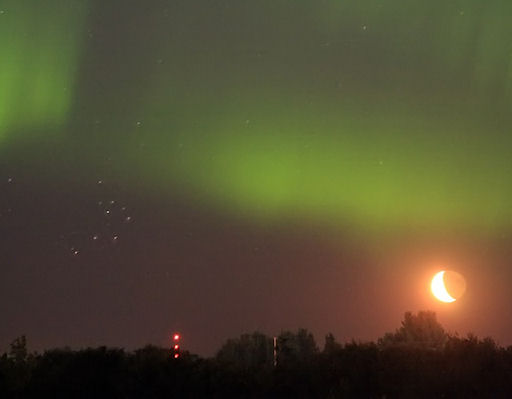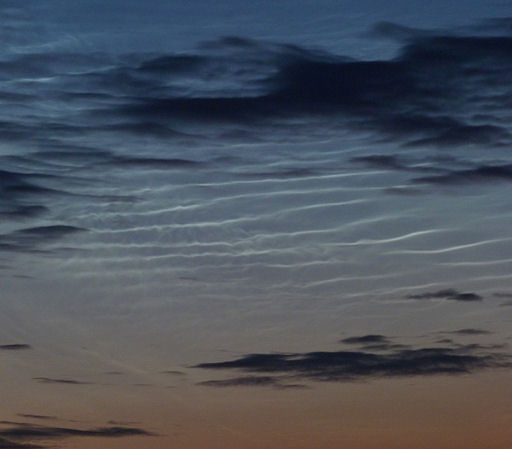Metallic photos of the sun by renowned photographer Greg Piepol bring together the best of art and science. Buy one or a whole set. They make a stellar gift. | | |
SPACESHIP AT DAWN: The International Space Station is beginning a series of bright morning passes over North America. Check the Simple Satellite Tracker for flyby times, then set your alarm to see a spaceship at dawn. It's a nice way to start the day.
AURORAS, MOON AND PLEAIDES: A high-speed solar wind stream is buffeting Earth's magnetic field, turning the skies over Canada green. Bob Johnson sends this picture from Saskatoon, Saskatchewan:

Photo details: Canon 40D, 140mm lens, 10 second exposure, ISO 3200.
"I went outside to see the Moon and Pleiades after midnight on July 25th when the auroras appeared," says Johnson. "It was beautiful."
More auroras are possible tonight as the solar wind continues to blow faster than ~500 km/s. Conditions favor observers in the southern hemisphere where skies are winter-dark. Aurora alerts: text, voice.
NOCTILUCENT CLOUDS: "The morning of July 26th was electric blue!" says Heiko Ulbricht of Freital, Saxony, Germany. "I woke up at 3 clock, looked out my bedroom window to the north and saw a stunning display of noctilucent clouds." Moments later, he dashed outside with a camera to record the view:

July has been an odd time for noctilucent clouds (NLCs). The month began with an extravagant display that stretched as far south as Colorado and Kansas--odd because NLCs are usually confined to higher latitudes. The event seemed to herald a period of widespread sightings. Observers were disappointed, though, when the clouds quickly retreated to their usual northern habitat. Could this German apparition signal renewed activity? Sky watchers at all latitudes should be alert for electric-blue ripples around sunrise and sunset. Observing tips may be found in the gallery.
more images: from Timo Newton-Syms of Helsinki, Finland
2011 Noctilucent Cloud Gallery
[previous years: 2003, 2004, 2005, 2006, 2007, 2008, 2009]
June 2011 Aurora Gallery
[Aurora alerts: text, voice] [previous Junes: 2010, 2008, 2001]
Potentially Hazardous Asteroids (
PHAs) are space rocks larger than approximately 100m that can come closer to Earth than 0.05 AU. None of the known PHAs is on a collision course with our planet, although astronomers are finding
new ones all the time.
On July 26, 2011 there were 1237 potentially hazardous asteroids.
Notes: LD means "Lunar Distance." 1 LD = 384,401 km, the distance between Earth and the Moon. 1 LD also equals 0.00256 AU. MAG is the visual magnitude of the asteroid on the date of closest approach. | | The official U.S. government space weather bureau |
| | The first place to look for information about sundogs, pillars, rainbows and related phenomena. |
| | Researchers call it a "Hubble for the sun." SDO is the most advanced solar observatory ever. |
| | 3D views of the sun from NASA's Solar and Terrestrial Relations Observatory |
| | Realtime and archival images of the Sun from SOHO. |
| | from the NOAA Space Environment Center |
| | the underlying science of space weather |
| | for out-of-this-world printing and graphics |

